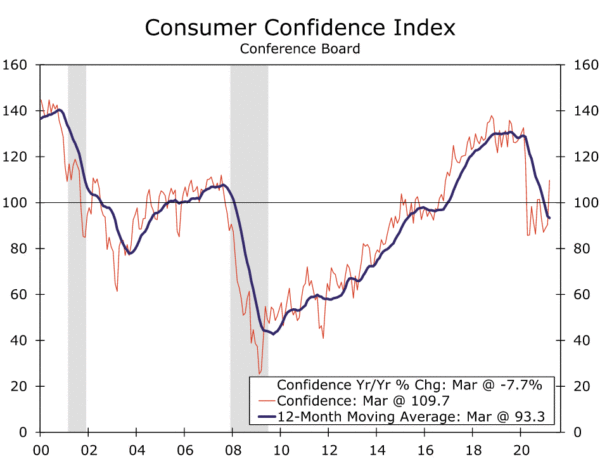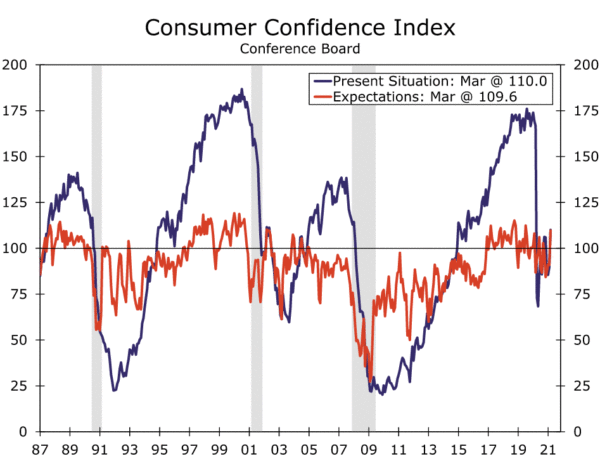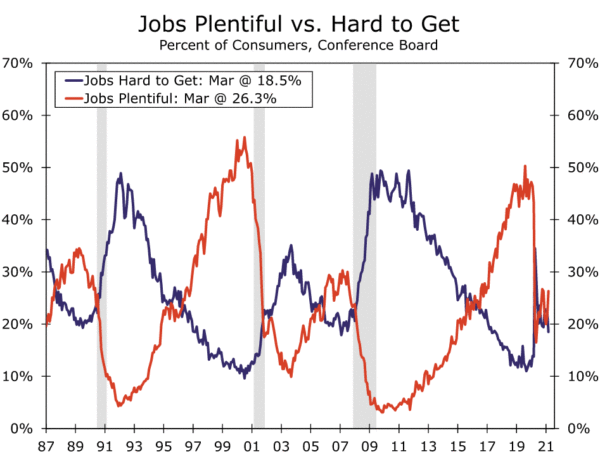Consumers certainly regained confidence in March. The headline print of 109.7 handily exceeded even the most optimist forecast with room to spare. After a run of mostly disappointing February data, this surge is consistent with our expectation that we are at the start of a consumer spending spree.
Opening Salvo
In the wake of the latest stimulus bill, most private-sector forecasters and the Federal Reserve have dialed-up their expectations for growth. That was a comfortable call to make after consumers started off the year with a January spending increase that was as strong as any month since the height of the re-opening spending spree last summer. But, February saw sharp declines in personal outlays due in part to severe weather. If these bullish forecasts for the economy are going to be right, the consumer sector will have to rebound quickly.
Right on cue, we got today’s above-consensus print for consumer confidence. Consensus forecasts ranged from a low of 88 to a high of 103. In the actual event, the 109.7 surpassed even the giddiest of forecasters by a margin of more than six points. After February’s modest increase, we said in a write-up for this indicator that it was only just the beginning and to a lesser extent that is still true – there is room for further rebound here. Consumer confidence was comfortably north of 120 for two years before the wheels started coming off the bus with the pandemic around this time last year.
Consumers See the Light at the End of the Tunnel
Unlike other periods when consumers only felt enthusiastic about a wistful distant day when the pandemic might end, there was major improvement across all time horizons. The fight against the virus may not be over, but good luck telling that to U.S. consumers flush with cash from the latest stimulus check. The present situations index, based on consumers take on current business and labor market conditions, rose to 110.0 from 89.6 in February. The forward-looking expectations index, which measures the outlook for income, business and job market conditions, also improved, rising to 109.6 in March, from 90.9 in February.
Are Jobs Plentiful or Hard-to-Get? Depends on Your Line of Work
The nearby chart plots the share of respondents viewing jobs as “hard to get” (blue line) versus those who see “jobs plentiful.” It typically is many years into an expansion before we see the red line overtake the blue line, yet here we see the share seeing jobs plentiful at 26.3%, which is more than seven points higher than the share who still see jobs as hard-to-get. This may reflect the long-struggles that people working in leisure and hospitality have had to contend with, even as manufacturing and construction companies complain that they cannot find the labor they need. A classic structural employment problem, but one that could be ameliorated when the economy fully re-opens this year. In fact, we expect to see some of that on Friday of this week when the March employment report hits the wire. We have an above-consensus call that the economy added 675K jobs in the month. Should we get something close to that, the “hard” data would show that jobs are plentiful indeed.















